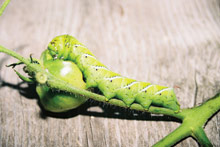I was in my garden the other day when an unfamiliar butterfly landed on a flower nearby. It was small and sleek, with long, narrow black wings that had white spots spread along them. Before I could get my camera, though, it was gone, off to sip another flower.

Later I consulted a field guide and figured out that what I’d seen was the adult of a species known as the grape leaf folder, Desmia funeralis.
The species name, funeralis, gave me pause, especially since my grapes have already gone through so much this year. Earlier in the season, leafhoppers arrived and pierced the vines’ new leaves, marking the edges with brown, sunken spots. Two weeks ago Japanese beetles showed up in biblical numbers and began making lace of the leaves. And when the beetles aren’t eating, they’re humping—ensuring that there will be more of them next year.
But at least those were pests I expected. The grape leaf folder’s appearance in my garden was something different, calling to mind the words of Job, who said, “That which I was afraid of is come upon me.”
Grapevines are susceptible to a number of pests. You’ve got your grape root borer, your phylloxera, your glassy-winged sharpshooter, your grape leafhopper, your grape flea beetle, grapevine aphid and grape berry moth. And that’s only the highlights. A few pests have powerfully descriptive names, like the grape cane girdler; tending toward the more sinister, there’s the grape leaf skeletonizer, which sounds less like an insect than a Marvel Comics villain.
According to organic-gardening wisdom, a plant that is unfairly targeted by insects is a sickly plant, lacking the necessary vigor to “outgrow” those pests—in the same way that an injured wart hog (or one that has recently received its AARP card) will be the first to fall under the cheetah’s hungry gaze.
That may be wisdom, all right, but in my opinion it’s incomplete. The world is full of predators, and they’re that way for a reason: they’re hungry, and a prey exists. A tomato plant whose leaves are purpling because of a phosphorous deficiency may be attractive to hornworms, but just as likely the healthy plant next to it will also be gnawed upon at some point in the season. Hornworms, to borrow a phrase, happen.
Given pesticides’ ecological implications, many people today rightfully take a dim view of them. But imagine what a miracle it must have seemed to that first cotton farmer who slopped lead arsenate onto his crop and watched the bollworms writhe and then disappear (for the moment, at least). We know better than to believe in “solutions,” and yet, judging by the array of killing granules, powders and liquids that crowd the shelves of local garden centers, that impulse is still there.
I think of my grandmother, a dedicated rose-grower for most of her life. The shelves in her garage were lined with all the magic potions of 20th-century gardening: Escar-Go!, Slug-Get-A, Carbaryl, Sevin, Diazinon, Lorsban and pretty much every product ever rolled out by Ortho. It smelled like a storm grate leading to hell, and still the pests came—the Japanese beetles, the slugs, the cane borers and earwigs.
My grapevines didn’t ask for trouble, and I’ve given them pretty much everything they require in the way of humus, fertilizer and mulch. At this point it would be easy to take their struggles as a sign of personal failure, but I’m hopeful that they—and I—will pull through this. After all, they’re still laying on new growth (though I did see an aphid or two at the tips).
So when the grape leaf folder larvae emerge—as they almost certainly will—I have a few choices. I can stand in the garden, Job-like, and shake a fist at a God who allows these things to happen. I can run to the store, buy some something toxic and let ‘em have it.
Or—and this is most likely the approach I’ll take—I can crack a beer and start scouting the leaves for caterpillars. I just hope they at least have the courtesy to fold the leaves into a pleasing pattern: a crane, say, or maybe a swan.



Before you comment
The comments section is here to provide a platform for civil dialogue on the issues we face together as a local community. Xpress is committed to offering this platform for all voices, but when the tone of the discussion gets nasty or strays off topic, we believe many people choose not to participate. Xpress editors are determined to moderate comments to ensure a constructive interchange is maintained. All comments judged not to be in keeping with the spirit of civil discourse will be removed and repeat violators will be banned. See here for our terms of service. Thank you for being part of this effort to promote respectful discussion.